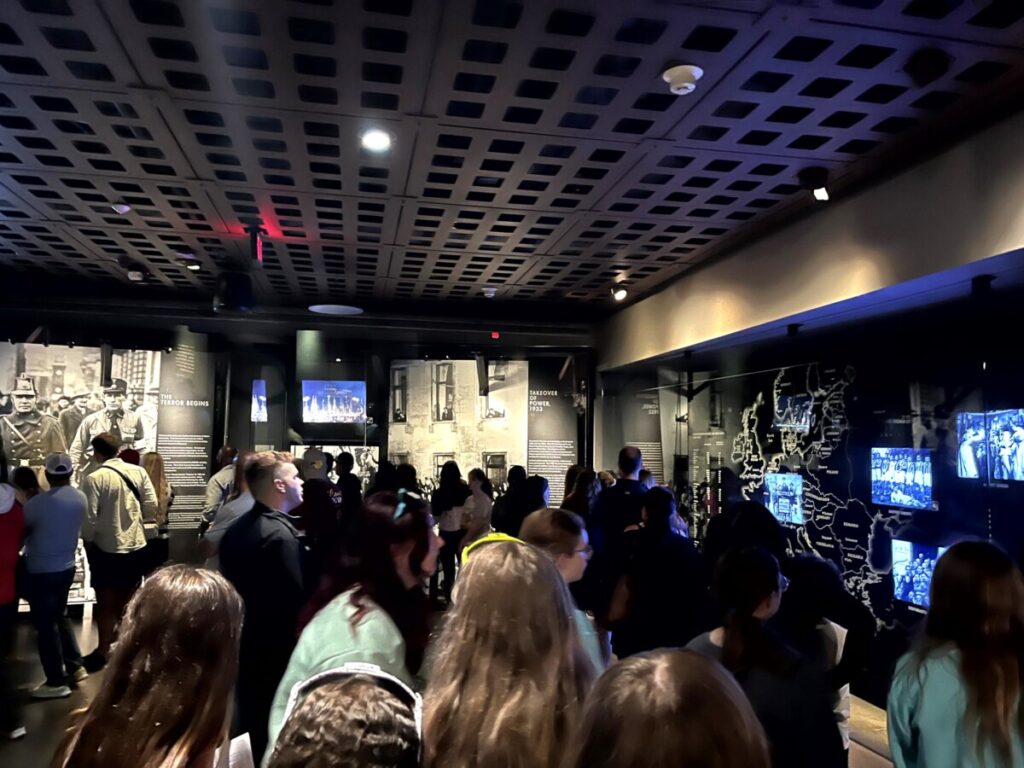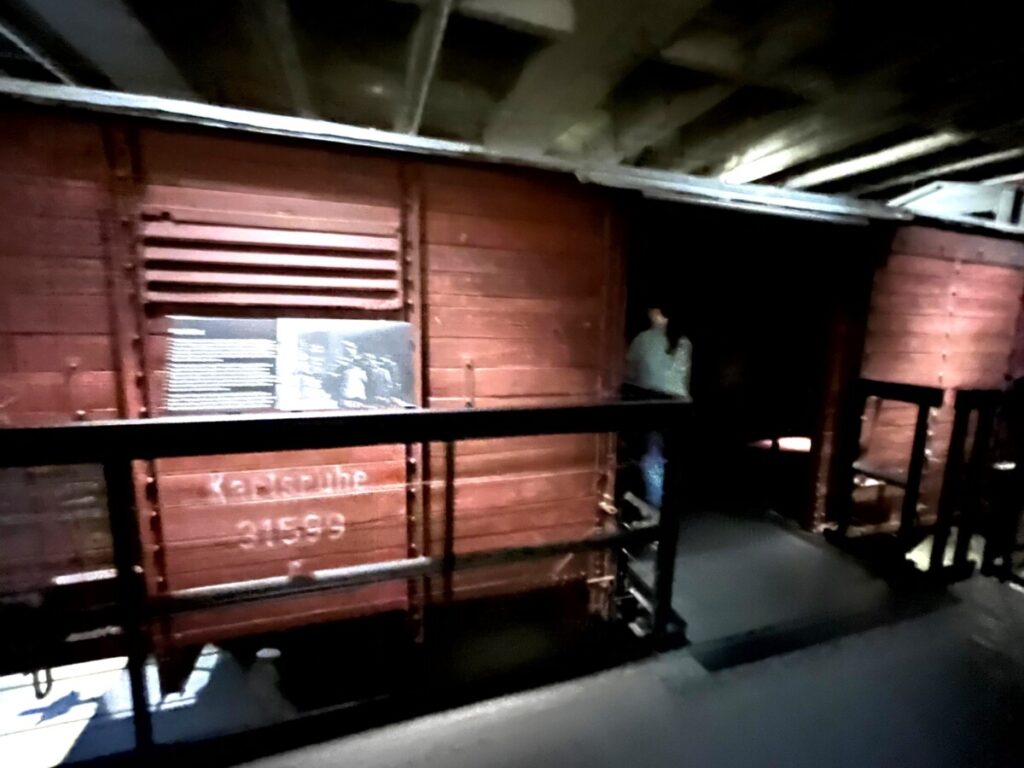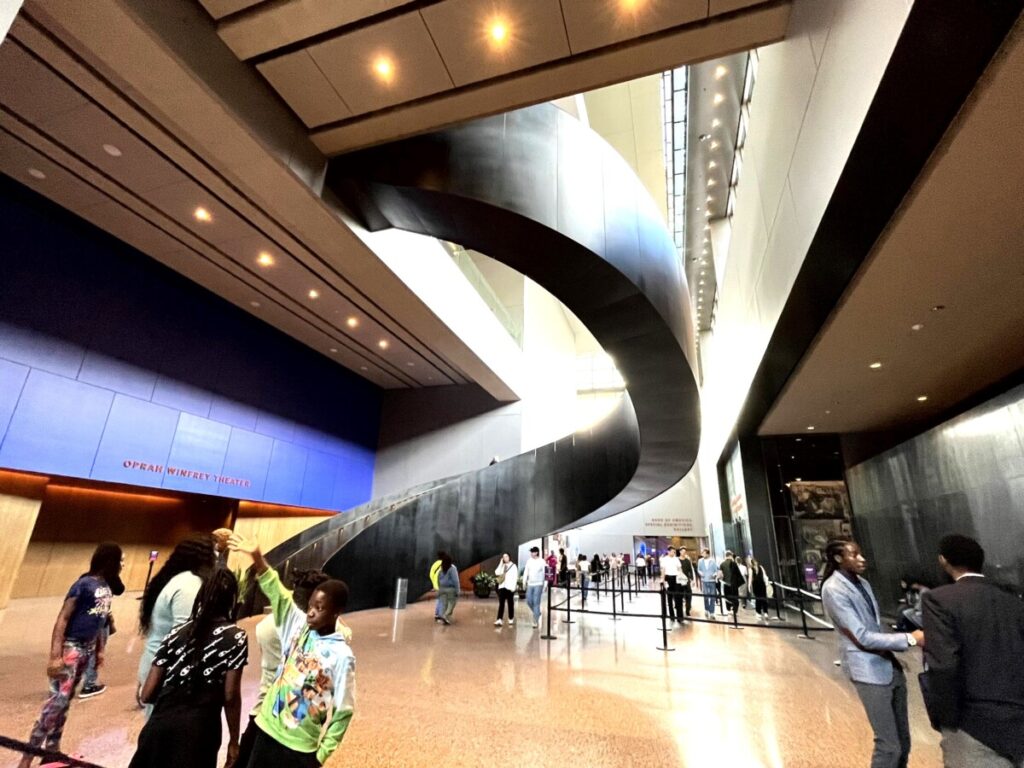After dropping our daughter (Thing 2) off in DC for her summer internship, we wanted to do some sightseeing. The US Holocaust Museum had always been on our list so we got online and reserved free tickets.
Both my husband and I have spent considerable time in DC. He lived here three years, while I interned for a US Congressman for a couple of summers. We also took our girls here in elementary school and again in 2021. The Holocaust Museum is one of the things we’ve never seen before.
US Holocaust Memorial Museum
The museum opened its doors in 1993, 13 years after US Congress voted to establish a national memorial to the six million Jews and others who died in the Holocaust. The government donated the land for the site and almost all the building’s construction cost came from private sector donations.
The exterior combines brick and limestone; two incongruent styles as if two different architects designed it. James Ingo Freed, who fled Nazi Germany as a child, spent 18 months creating the 285,000-square-foot museum.

Inside, we entered an atrium called the Hall of Witnesses. The red brick walls with steel beams and windows on the ceiling felt like an old warehouse but also somewhat like a train station. I later read that Freed chose to “confuse” the visitor to get the focus off of the present outside world but to enter the chaotic times during the Holocaust.
The Holocaust Exhibit
The main exhibit is the three-story Holocaust Exhibit. Museum employees ushered us onto large elevators that took us to the third floor to begin our self-guided tour. In years past, the museum gave ID cards to visitors of actual people during the Holocaust. In addition to a biography, the booklet details where the person was during the Holocaust and their final fate. I’m assuming the museum discontinued this as it was unavailable on our visit.

Visitors reserve timed tickets online for a $1 transaction fee but expect crowds – often high school groups touring from other parts of the country. The museum doesn’t display many artifacts. Instead, the story of the Holocaust is told through pictures, newspaper headlines, and placards on the wall. So pack a lot of patience with you as you may stand three rows deep trying to read the placards. The information presented is very detailed and takes time to absorb.
Nazi Assault
The top floor of the exhibit shows the progression of the Nazi regime’s power between 1933-1939. The laws passed against the Jews came subtly. For example, the first laws banned Jews from government posts and then from newspaper editorial positions. However, by 1938, Jewish doctors, nurses, and lawyers could no longer practice, Jewish shopkeepers had to sell out to Aryans, and Jewish schoolchildren were prohibited from public school. By 1939, over 400 laws had been passed to deny basic human rights to the Jews.
The Nazis targeted other groups as well. The Roma (gypsies), Communists, Social Democrats, homosexuals, Jehovah’s Witnesses, and other groups faced imprisonment.
We walked through the three-story Tower of Faces (pictured in the cover photo). Donated by Yaffa Eliach, these photos came from Eisiskes, a Polish (now Lithuanian) town where only 29 Jews survived the Nazi attack in 1941. A survivor of the attack, Dr. Eliach went on to establish the Center for Holocaust Studies, Documentation, and Research in Brooklyn after years of interviews with Holocaust survivors.
The Final Solution
A bridge to the other side of the atrium took us past a row of art exhibits and down the stairs. The middle floor covered 1940-1945 with the deportation of Jewish people to the ghettos and the concentration camps. Today, we see the Holocaust in hindsight but at the time the Germans told many Jews they were being moved to a better place. For example, the Nazis promoted Theresienstadt as a spa town for elderly German Jews to retire.

A chilling exhibit was artwork by children at Theresienstadt, a camp/ghetto originally designated for Czech Jews. Friedl Dicker-Brandeis (1898-1944) taught art classes to the children in the ghetto. In 1944, the Nazi propaganda “fixed up” Theresienstadt for an inspection by the International Red Cross. In reality, the camp served as a way-station to the death camps. Officials later sent Dicker-Brandeis and 90% of the 15,000 Theresienstadt children to their deaths in Auschwitz. Before her deportation, the artist hid over 4,000 pieces of the children’s art in a dorm.
On this floor, visitors could also walk through a freight car used to transport people to concentration camps such as Dachau, Auschwitz, and Bergen-Belson. Just stepping inside for a few seconds, I felt how dark, small, and claustrophobic the railcar was. Many deportees traveled in these cars packed with so many people, that they couldn’t sit down for days on end, and often without food and water. Later, we walked into a room to see bunks that housed people in the camps and doors to the gas chambers.

In a room off to the side, visitors can sit down, put on headphones, and listen to oral testimonies from survivors of Auschwitz. A written transcription is available to read along. Hearing the voices made the experience much more personal.
Last Chapter
The bottom floor begins with aid from other countries and citizens. We’ve all heard of the French Resistance. In particular, the French town of Le Chambon-sur-Lignon helped smuggle some 3,500 Jewish people fleeing Vichy France. In Bulgaria, after the deportation of 11,000 Jews from Macedonia and Thrace to death camps, the citizens protested and saved the deportation of 9,000 Jews scheduled for the next deportation. Even the Belgians refused to deport 25,000 Jews.
The rest of the exhibit details the liberation of the camps by the Russian, British, and American troops, as well as post-war trials in Nuremberg. The museum discusses Zionism and the push for Jewish people to create Israel. The exhibit concludes in a theatre area with video clips of concentration camp survivors.
A powerful exhibit that has been removed temporarily is the shoe room which displays shoes from the prisoners at the Majdanet camp. Instead, a black-and-white picture of the shoes stacked next to the Polish camp at its liberation in 1944 proved a powerful visual aid for us.
Hall of Remembrance
For me, the most poignant part of the museum was the Hall of Remembrance. A hushed silence fell upon entering the hexagon-shaped room where the eternal flame burned in front of one wall. On the adjoining walls, visitors could light candles in memory of Holocaust survivors. Names of concentration camps, etched in granite above the rows of candles, reminded visitors of the magnitude of this atrocity. Though somber, light filled the room from the skylight above and windows between the wall panels. I needed this space to take in everything that I had just learned and to pay my respects to the victims.
Other Exhibits
Guests only need timed tickets to view the Holocaust exhibit, which takes about two hours. The rest of the museum offers much more to see. Children over age eight can learn about the Holocaust through a youngster’s viewpoint in Daniel’s Story. Other exhibits include Americans and the Holocaust, American Witnesses, and more.
Lunch at National Museum of African American History and Culture- Sweet Home Cafe
The Smithsonian’s National Museum of African American History and Culture is just a 5-10 minute walk on 14th street with views of the Washington Monument and the US Capital. We stopped here to eat at the restaurant Sweet Home Cafe.

Located on the bottom floor, the cafe serves fried chicken, BBQ pork, and sides such as collard greens, sweet potatoes, and macaroni and cheese. After a tasty lunch, we all agreed with its high rankings among the Smithsonian restaurants.
We popped our heads into the Slavery and Freedom exhibit, but could quickly see we needed more time to absorb it all. We decided to visit the museum on another trip to DC. The Holocaust and Slavery are two heavy and thought-provoking topics. We didn’t have the mental energy to do both on the same day.
In Conclusion
Despite the crowds, the Holocaust Museum is worthy of a visit – even for middle and high school students. Visiting early on a weekday may be less crowded. Plan for lots of time and don’t try to rush the exhibits.
Click for more information about the US Holocaust Memorial Museum, click here.

Pingback: Belmont-Paul Women's Equality National Monument - Washington, DC • Finding Family Adventures